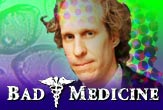The Good, the Bad and the Ugly Sperm

With more than 500 sperm banks in the United States and tens of thousands of donors, it was bound to happen. As reported Friday in the Journal of Pediatrics, a sperm donor from Michigan passed on a rare and potentially deadly genetic disorder to five children.
The disorder, called severe congenital neutropenia, affects only one in five million newborns. Those with the disorder lack a certain type of white blood cell, and this leaves them vulnerable to a host of infections and also leukemia. Fortunately medication, albeit at $200 a day, can keep white blood cell counts high.
Doctors thought it was more than a coincidence when five kids born to four couples in the Detroit area were discovered with congenital neutropenia. They traced it back to one sperm bank and one man.
For now this seems to be an honest mistake. The donor, known but unnamed in the report, could have been an asymptomatic carrier of the disease. (The only problem is that his whereabouts are unknown; the children are several years old now, and the donor has fathered other children.) The sperm bank, known but unnamed in the report, only screens for about ten of the most common hereditary diseases, such as cystic fibrosis.
Maybe the incident will bring about more rigorous genetic testing. But no one seems to care about the biggest flaw in the system.
Well, at least his eyes were blue...
What's really wrong with sperm donation? Einstein wouldn't have stood a chance. He would have been deemed too short. Genius, check. Humanitarian, check. What? Under 5'9"? Hit the road, Jack.
Sign up for the Live Science daily newsletter now
Get the world’s most fascinating discoveries delivered straight to your inbox.
That's right: Most sperm banks draw the line at 5'11". We're weeding out the weaklings. Sperm banks can't be expected to screen for rare genetic disorders when there are so many more pressing concerns to find out about the donor, such as baldness, salary history, hobbies and taste in clothing.
I know there are fatal fashion mistakes, but I didn't think this was genetic. Nevertheless, sperm is big business, and most sperm banks carry only those donors with characteristics most desirable to their clientele.
A March 2006 New York Times Magazine article relayed tales of single women shopping for sperm as if it were online dating. And sperm donation questionnaires viewable on the Internet confirm the inane selection criteria. Some women are looking for donors from wealthy families or with an agreeable list of heroes and aspirations, as if that will somehow magically rub off on their child who will never know the biological father. Some are looking for donors of a specific religion, such as Catholics, although anyone masturbating into a cup once a week for a couple of years probably commits a sin or two.
I'm looking for the tweed jacket gene...
Sperm banks weed out the short and bald and even those potential donors with a grandparent who died young, and it leaves us with those loveable jocks. Sounds innocent enough. What parents want a child who, given the 50-50 chance of being a boy, could go bald at age 45 after the parents are dead?
But it's not so innocent. Darker skin donors are not as desirable as those with lighter skin, even among African American clientele. Yet who can blame the parents when the stupid society we live in shuns darker skin (and short stature and bald heads).
Between federal regulations and recipient and sperm bank preferences, the whole system smells a bit like eugenics.
Last year the Food and Drug Administration essentially banned gay men from donating, citing the risk of HIV-infected sperm. (They would have to abstain from homosexual sex for five years.) Like blood, sperm can be and is tested for the virus, so the ban seems entirely biased against gay sexual orientation.
The U.S. Immigration Act of 1924 established quotas that limited immigration from southern and eastern Europe to about 10 percent and prohibited Asian immigration, while allocating 86 percent of quotas to western and northern Europe. This was a eugenicist-driven law with the stated aim of improving the gene pool of the American population. While only a small percentage of children in America are being conceived from what consumers and the FDA consider perfect sperm, I can't help but think we are heading in the wrong direction once again.
Christopher Wanjek is the author of the books “Bad Medicine” and “Food At Work.” Got a question about Bad Medicine? Email Wanjek. If it’s really bad, he just might answer it in a future column. Bad Medicine appears each Tuesday on LIveScience.
More Bad Medicine
- When a Rolling Stone Bounces
- Treating the Symptoms: What's Wrong with U.S. Health Care
- Vitamin Mania: The Truth about Antioxidants
- Zacarias Moussaoui: Wicked But Not Schizophrenic
- Suffocating Trends: Oxygen Bars and Drinks
- Few Clues to High IQs
- Licensed to Kill: Some Doctors are Real Naturals
- War on Bacteria is Wrongheaded
- Soda Sales Go Flat, Industry Fights Back
- Go Ahead, Drink Bacon Grease for Breakfast

Christopher Wanjek is a Live Science contributor and a health and science writer. He is the author of three science books: Spacefarers (2020), Food at Work (2005) and Bad Medicine (2003). His "Food at Work" book and project, concerning workers' health, safety and productivity, was commissioned by the U.N.'s International Labor Organization. For Live Science, Christopher covers public health, nutrition and biology, and he has written extensively for The Washington Post and Sky & Telescope among others, as well as for the NASA Goddard Space Flight Center, where he was a senior writer. Christopher holds a Master of Health degree from Harvard School of Public Health and a degree in journalism from Temple University.









